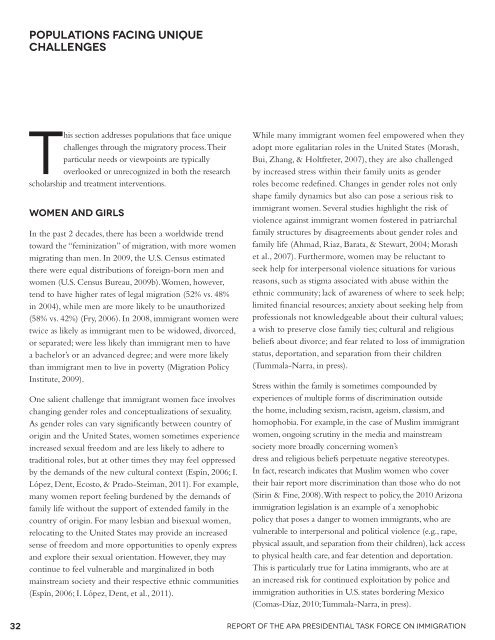Crossroads: The Psychology of Immigration in the New Century
Crossroads: The Psychology of Immigration in the New Century
Crossroads: The Psychology of Immigration in the New Century
You also want an ePaper? Increase the reach of your titles
YUMPU automatically turns print PDFs into web optimized ePapers that Google loves.
Populations Fac<strong>in</strong>g Unique<br />
Challenges<br />
This section addresses populations that face unique<br />
challenges through <strong>the</strong> migratory process. <strong>The</strong>ir<br />
particular needs or viewpo<strong>in</strong>ts are typically<br />
overlooked or unrecognized <strong>in</strong> both <strong>the</strong> research<br />
scholarship and treatment <strong>in</strong>terventions.<br />
Women and Girls<br />
In <strong>the</strong> past 2 decades, <strong>the</strong>re has been a worldwide trend<br />
toward <strong>the</strong> “fem<strong>in</strong>ization” <strong>of</strong> migration, with more women<br />
migrat<strong>in</strong>g than men. In 2009, <strong>the</strong> U.S. Census estimated<br />
<strong>the</strong>re were equal distributions <strong>of</strong> foreign-born men and<br />
women (U.S. Census Bureau, 2009b). Women, however,<br />
tend to have higher rates <strong>of</strong> legal migration (52% vs. 48%<br />
<strong>in</strong> 2004), while men are more likely to be unauthorized<br />
(58% vs. 42%) (Fry, 2006). In 2008, immigrant women were<br />
twice as likely as immigrant men to be widowed, divorced,<br />
or separated; were less likely than immigrant men to have<br />
a bachelor’s or an advanced degree; and were more likely<br />
than immigrant men to live <strong>in</strong> poverty (Migration Policy<br />
Institute, 2009).<br />
One salient challenge that immigrant women face <strong>in</strong>volves<br />
chang<strong>in</strong>g gender roles and conceptualizations <strong>of</strong> sexuality.<br />
As gender roles can vary significantly between country <strong>of</strong><br />
orig<strong>in</strong> and <strong>the</strong> United States, women sometimes experience<br />
<strong>in</strong>creased sexual freedom and are less likely to adhere to<br />
traditional roles, but at o<strong>the</strong>r times <strong>the</strong>y may feel oppressed<br />
by <strong>the</strong> demands <strong>of</strong> <strong>the</strong> new cultural context (Espín, 2006; I.<br />
López, Dent, Ecosto, & Prado-Steiman, 2011). For example,<br />
many women report feel<strong>in</strong>g burdened by <strong>the</strong> demands <strong>of</strong><br />
family life without <strong>the</strong> support <strong>of</strong> extended family <strong>in</strong> <strong>the</strong><br />
country <strong>of</strong> orig<strong>in</strong>. For many lesbian and bisexual women,<br />
relocat<strong>in</strong>g to <strong>the</strong> United States may provide an <strong>in</strong>creased<br />
sense <strong>of</strong> freedom and more opportunities to openly express<br />
and explore <strong>the</strong>ir sexual orientation. However, <strong>the</strong>y may<br />
cont<strong>in</strong>ue to feel vulnerable and marg<strong>in</strong>alized <strong>in</strong> both<br />
ma<strong>in</strong>stream society and <strong>the</strong>ir respective ethnic communities<br />
(Espín, 2006; I. López, Dent, et al., 2011).<br />
While many immigrant women feel empowered when <strong>the</strong>y<br />
adopt more egalitarian roles <strong>in</strong> <strong>the</strong> United States (Morash,<br />
Bui, Zhang, & Holtfreter, 2007), <strong>the</strong>y are also challenged<br />
by <strong>in</strong>creased stress with<strong>in</strong> <strong>the</strong>ir family units as gender<br />
roles become redef<strong>in</strong>ed. Changes <strong>in</strong> gender roles not only<br />
shape family dynamics but also can pose a serious risk to<br />
immigrant women. Several studies highlight <strong>the</strong> risk <strong>of</strong><br />
violence aga<strong>in</strong>st immigrant women fostered <strong>in</strong> patriarchal<br />
family structures by disagreements about gender roles and<br />
family life (Ahmad, Riaz, Barata, & Stewart, 2004; Morash<br />
et al., 2007). Fur<strong>the</strong>rmore, women may be reluctant to<br />
seek help for <strong>in</strong>terpersonal violence situations for various<br />
reasons, such as stigma associated with abuse with<strong>in</strong> <strong>the</strong><br />
ethnic community; lack <strong>of</strong> awareness <strong>of</strong> where to seek help;<br />
limited f<strong>in</strong>ancial resources; anxiety about seek<strong>in</strong>g help from<br />
pr<strong>of</strong>essionals not knowledgeable about <strong>the</strong>ir cultural values;<br />
a wish to preserve close family ties; cultural and religious<br />
beliefs about divorce; and fear related to loss <strong>of</strong> immigration<br />
status, deportation, and separation from <strong>the</strong>ir children<br />
(Tummala-Narra, <strong>in</strong> press).<br />
Stress with<strong>in</strong> <strong>the</strong> family is sometimes compounded by<br />
experiences <strong>of</strong> multiple forms <strong>of</strong> discrim<strong>in</strong>ation outside<br />
<strong>the</strong> home, <strong>in</strong>clud<strong>in</strong>g sexism, racism, ageism, classism, and<br />
homophobia. For example, <strong>in</strong> <strong>the</strong> case <strong>of</strong> Muslim immigrant<br />
women, ongo<strong>in</strong>g scrut<strong>in</strong>y <strong>in</strong> <strong>the</strong> media and ma<strong>in</strong>stream<br />
society more broadly concern<strong>in</strong>g women’s<br />
dress and religious beliefs perpetuate negative stereotypes.<br />
In fact, research <strong>in</strong>dicates that Muslim women who cover<br />
<strong>the</strong>ir hair report more discrim<strong>in</strong>ation than those who do not<br />
(Sir<strong>in</strong> & F<strong>in</strong>e, 2008). With respect to policy, <strong>the</strong> 2010 Arizona<br />
immigration legislation is an example <strong>of</strong> a xenophobic<br />
policy that poses a danger to women immigrants, who are<br />
vulnerable to <strong>in</strong>terpersonal and political violence (e.g., rape,<br />
physical assault, and separation from <strong>the</strong>ir children), lack access<br />
to physical health care, and fear detention and deportation.<br />
This is particularly true for Lat<strong>in</strong>a immigrants, who are at<br />
an <strong>in</strong>creased risk for cont<strong>in</strong>ued exploitation by police and<br />
immigration authorities <strong>in</strong> U.S. states border<strong>in</strong>g Mexico<br />
(Comas-Díaz, 2010; Tummala-Narra, <strong>in</strong> press).<br />
32 Report <strong>of</strong> <strong>the</strong> APA Presidential Task Force on <strong>Immigration</strong>
















